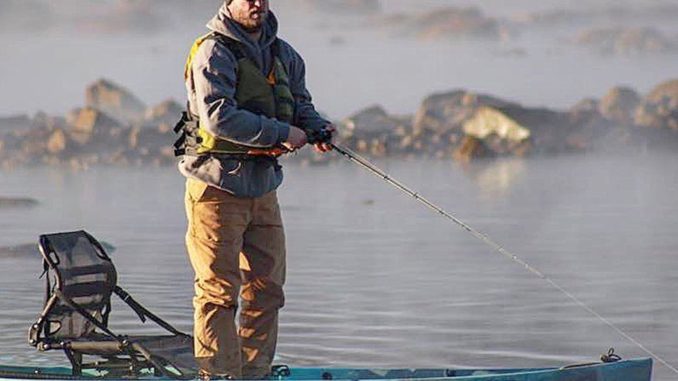
Many of winter’s adverse effects disappear in moving water
Of all the places to fish during February, some of the most-productive areas are flowing rivers where fish don’t have the luxury of going insanely deep and dormant like they tend to do in reservoirs.
While river fish, primarily black bass species, may move deep at times, deep is something like 15 feet. That’s easy enough to reach with a suspending jerkbait or slow-rolled spinnerbait.
The bonus is that, with a few flicks of their tails, these same fish can be in the shallows, offering some good subsurface and even schooling action when bait is present.
Steward Venable loves to fish inland rivers during the winter. Near his home in the Charlotte/Rock Hill area, the stretches of the Catawba River are broken by impoundments. This means current is often dictated by water releases upstream — even from as far away as 15 miles. He said current will often trigger black bass and striped bass to feed.
Stained water warms more quickly
Even in areas where current is not a factor, Venable likes to fish water with some stain or color. It warms more quickly on sunny days and offers the addition of better ambush conditions for fish.
On his river forays, Venable often puts in and paddles 3 to 4 miles in either direction. He paddles back and takes out at the same location. On days with heavy current and an additional angler, he may opt for a float trip of several miles, working downstream.
Venable said current flows dictate how the fish relate. On more extreme winter days, residents in localized areas have their furnaces going full blast. So utility companies that operate the dams run more water to meet the power demand.
He said rainfall will dictate water color. His favorite situation is finding a smaller tributary that is dumping warmer, stained water into the main river. He likes to target the downcurrent side of any structure but said fish may hold on the bottom out of the current or may even be slightly up in the tributary.
Venable will also fish slower-moving coastal rivers. On these rivers, he concentrates more on stationary objects like rock piles or blowdown trees. And he uses more-conventional soft plastics to tempt fish holding on structure.
Once he reaches blackwater on a coastal stretch of river, he will revert to using blade baits. But he prefers something in a gold color with smaller blades to make a smaller profile bait.
Venable makes it a habit to wear his PFD when fishing from his kayak year-round, but particularly when the weather and the water are cold He suggests packing along a spare change of clothes in a dry bag in case of a spill.
Best day on the water
As a part-time kayak-fishing guide, Stewart Venable has to fish whenever he can, even on cold days when the weather seems bleak. On just such a day two years ago, Venable was scheduled to meet a client who cancelled because of the near-freezing air temps and low-40s water temperatures on the lower Catawba River just upstream from Fishing Creek Reservoir.
Deciding he would fish anyway, Venable spent the morning slow-rolling spinnerbaits through deep pools hoping for a big largemouth bass. After several hours without a bite, he paddled into the mouth of a tributary where the creek bank blocked the wind so he could eat lunch.
“The water came up out of maybe 20 to 25 feet in the river into the drainage that was only like a foot deep. I noticed some baitfish flipping,” Venable said. “I cast a hard-plastic jerkbait — I think it was a Megabass 110 JR — over and BAM!, hooked up with a 4-pounder.”
For the next hour-and-a-half, Venable worked a 50-yard stretch of river that produced over a dozen bass averaging 4 ½ pounds.
“I had almost 25 pounds of bass in my best 5 fish, including a big 7-pounder,” he said.
Since that day, Venable learned to always keep an eye on his surroundings and look for fish feeding in places they are not supposed to feed under the circumstances.
Stain can mean gain
In the winter, stained water usually means warmer water, because the sun will warm the tiny particles of dirt or mud suspended in the water much faster than clear water. Warm water will draw winter bass. Fish the downcurrent side of the stained water first, then move toward its source, which is often a tributary creek.

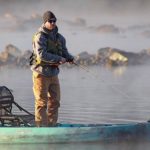
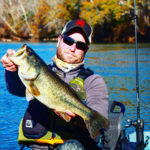
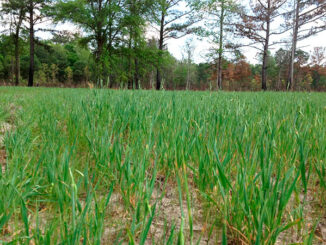
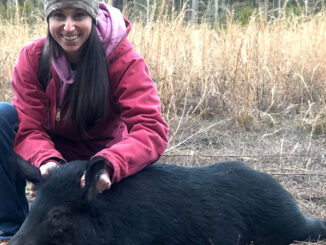
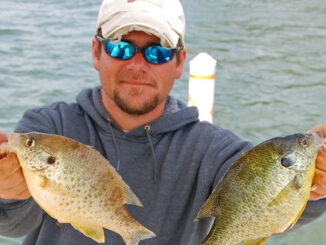

Be the first to comment